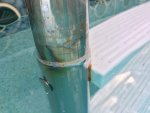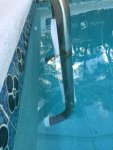I recently purchased my first home (with an existing in-ground pool). Within my first month, I converted to Salt Water. 6 months later, I decided to replace the already rusted, existing Rail & Ladder.
The company I went with was aware I had a salt water pool. I requested a Stainless Steel Rail + Ladder. In less than 2 months, the Ladder (only) was rusting. The company came back out, took their own photos (mine were apparently unclear, I've attached to this post) and took a sample of the pool water. Everything came back accurate, so they agreed to replace.
Not even 2 months later, the new Ladder was rusting AGAIN!
Keep in mind, the Rail which they installed at the same time, is doing just fine.
Last week, they emailed me stating "We believe when your pool was originally constructed the builder never bonded the deck anchors properly". Question 1: Is that true?? Could the deck anchors cause a ladder inside the pool to rust?
I tried to research myself, and I went back to the original invoice to get more information. I had paid extra for "CORE DRILLED OUT AND REMOVED FUSED IN ALUMINUM DECK ANCHORS SECURED TWO UPGRADED BRASS DECK ANCHORS. DECK ANCHORS, MISC MATERIAL AND LABOR" They're telling me the original deck anchors were not being bonded correctly, but unless the invoice is incorrect that they had "Removed the fused in aluminum deck anchors", Question 2: shouldn't their theory of the the deck anchors not bonded properly be a non-issue since those had been replaced?
The invoice also said I paid for a SS ladder with SS steps. They installed a SS with PLASTIC steps. Is this company trying to pull a fast one on me?
The company I went with was aware I had a salt water pool. I requested a Stainless Steel Rail + Ladder. In less than 2 months, the Ladder (only) was rusting. The company came back out, took their own photos (mine were apparently unclear, I've attached to this post) and took a sample of the pool water. Everything came back accurate, so they agreed to replace.
Not even 2 months later, the new Ladder was rusting AGAIN!
Keep in mind, the Rail which they installed at the same time, is doing just fine.
Last week, they emailed me stating "We believe when your pool was originally constructed the builder never bonded the deck anchors properly". Question 1: Is that true?? Could the deck anchors cause a ladder inside the pool to rust?
I tried to research myself, and I went back to the original invoice to get more information. I had paid extra for "CORE DRILLED OUT AND REMOVED FUSED IN ALUMINUM DECK ANCHORS SECURED TWO UPGRADED BRASS DECK ANCHORS. DECK ANCHORS, MISC MATERIAL AND LABOR" They're telling me the original deck anchors were not being bonded correctly, but unless the invoice is incorrect that they had "Removed the fused in aluminum deck anchors", Question 2: shouldn't their theory of the the deck anchors not bonded properly be a non-issue since those had been replaced?
The invoice also said I paid for a SS ladder with SS steps. They installed a SS with PLASTIC steps. Is this company trying to pull a fast one on me?



